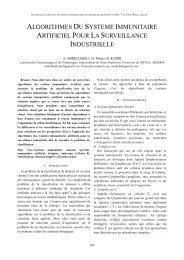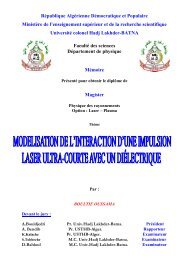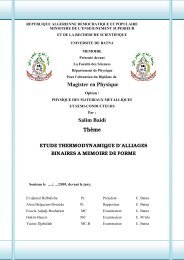- Page 1 and 2: Europe's Quest for the Universe Lod
- Page 3 and 4: Cover: THE VLT Array on the Paranal
- Page 6 and 7: Preface What a magnificent title,
- Page 8: Acknowledgements First of all I wou
- Page 11 and 12: 8 Europe’s quest for the Universe
- Page 13: 10 Europe’s quest for the Univers
- Page 17 and 18: 14 Europe’s quest for the Univers
- Page 19 and 20: 16 Europe’s quest for the Univers
- Page 21 and 22: 18 Europe’s quest for the Univers
- Page 23 and 24: 20 Europe’s quest for the Univers
- Page 25 and 26: 22 Europe’s quest for the Univers
- Page 28 and 29: II. ESO, La Silla, the 3.6-m Telesc
- Page 30 and 31: ESO, La Silla, the 3.6 m Telescope
- Page 32 and 33: ESO, La Silla, the 3.6 m Telescope
- Page 34 and 35: ESO, La Silla, the 3.6 m Telescope
- Page 36 and 37: ESO, La Silla, the 3.6 m Telescope
- Page 38 and 39: ESO, La Silla, the 3.6 m Telescope
- Page 40 and 41: ESO, La Silla, the 3.6 m Telescope
- Page 42 and 43: ESO, La Silla, the 3.6 m Telescope
- Page 44 and 45: ESO, La Silla, the 3.6 m Telescope
- Page 46 and 47: III. Origin of the VLT Project; The
- Page 48 and 49: Origin of the VLT Project; The NTT
- Page 50 and 51: Origin of the VLT Project; The NTT
- Page 52 and 53: Origin of the VLT Project; The NTT
- Page 54 and 55: Origin of the VLT Project; The NTT
- Page 56 and 57: Origin of the VLT Project; The NTT
- Page 58 and 59: Origin of the VLT Project; The NTT
- Page 60 and 61: Origin of the VLT Project; The NTT
- Page 62 and 63: IV. Technological, Financial and Sc
- Page 64 and 65:
Technological, Financial and Scient
- Page 66 and 67:
Technological, Financial and Scient
- Page 68 and 69:
Technological, Financial and Scient
- Page 70 and 71:
Technological, Financial and Scient
- Page 72 and 73:
V. Construction of the VLT Could we
- Page 74 and 75:
Construction of the VLT 71 contract
- Page 76 and 77:
Construction of the VLT 73 of the p
- Page 78 and 79:
Construction of the VLT 75 Figure V
- Page 80 and 81:
Construction of the VLT 77 The desi
- Page 82 and 83:
Construction of the VLT 79 Agreemen
- Page 84 and 85:
Construction of the VLT 81 to 272 M
- Page 86 and 87:
Construction of the VLT 83 telescop
- Page 88:
Construction of the VLT 85 Supporte
- Page 91 and 92:
88 Europe’s quest for the Univers
- Page 93 and 94:
90 Europe’s quest for the Univers
- Page 95 and 96:
Figure VI, 3. Map of northern Chile
- Page 97 and 98:
94 Europe’s quest for the Univers
- Page 99 and 100:
96 Europe’s quest for the Univers
- Page 101 and 102:
98 Europe’s quest for the Univers
- Page 103 and 104:
100 Europe’s quest for the Univer
- Page 105 and 106:
102 Europe’s quest for the Univer
- Page 107 and 108:
104 Europe’s quest for the Univer
- Page 109 and 110:
106 Europe’s quest for the Univer
- Page 112 and 113:
VII. The VLT Observatory: Adaptive
- Page 114 and 115:
The VLT Observatory 111 effects. Ho
- Page 116 and 117:
The VLT Observatory 113 member coun
- Page 118 and 119:
The VLT Observatory 115 Table VII,
- Page 120 and 121:
The VLT Observatory 117 the NTT and
- Page 122 and 123:
Interferometry The VLT Observatory
- Page 124 and 125:
The VLT Observatory 121 Figure VII,
- Page 126 and 127:
VIII. Ground and Space Based Optica
- Page 128 and 129:
Ground and Space Based Optical Tele
- Page 130 and 131:
HST and VLT Ground and Space Based
- Page 132 and 133:
HST and VLT are complementary. Beca
- Page 134 and 135:
Ground and Space Based Optical Tele
- Page 136 and 137:
Ground and Space Based Optical Tele
- Page 138 and 139:
Ground and Space Based Optical Tele
- Page 140 and 141:
seeing conditions prevail; the latt
- Page 142 and 143:
IX. Radio Astronomy; ALMA and SKA A
- Page 144 and 145:
Radio Astronomy; ALMA and SKA 141 a
- Page 146 and 147:
Radio Astronomy; ALMA and SKA 143 w
- Page 148 and 149:
at Jodrell Bank. Baselines range up
- Page 150 and 151:
science remains compelling. We stil
- Page 152 and 153:
Radio Astronomy; ALMA and SKA 149 A
- Page 154 and 155:
Radio Astronomy; ALMA and SKA 151 w
- Page 156 and 157:
ALMA Radio Astronomy; ALMA and SKA
- Page 158 and 159:
Radio Astronomy; ALMA and SKA 155 F
- Page 160 and 161:
Radio Astronomy; ALMA and SKA 157 S
- Page 162:
Radio Astronomy; ALMA and SKA 159 o
- Page 165 and 166:
162 Europe’s quest for the Univer
- Page 167 and 168:
164 Europe’s quest for the Univer
- Page 169 and 170:
CLUSTER DOUBLE STAR 1 9 9 0 2 0 0 0
- Page 171 and 172:
168 Europe’s quest for the Univer
- Page 173 and 174:
170 Europe’s quest for the Univer
- Page 175 and 176:
172 Europe’s quest for the Univer
- Page 177 and 178:
174 Europe’s quest for the Univer
- Page 179 and 180:
176 Europe’s quest for the Univer
- Page 181 and 182:
178 Europe’s quest for the Univer
- Page 183 and 184:
180 Europe’s quest for the Univer
- Page 185 and 186:
182 Europe’s quest for the Univer
- Page 187 and 188:
184 Europe’s quest for the Univer
- Page 189 and 190:
186 Europe’s quest for the Univer
- Page 191 and 192:
188 Europe’s quest for the Univer
- Page 193 and 194:
190 Europe’s quest for the Univer
- Page 195 and 196:
192 Europe’s quest for the Univer
- Page 197 and 198:
194 Europe’s quest for the Univer
- Page 199 and 200:
196 Europe’s quest for the Univer
- Page 201 and 202:
198 Europe’s quest for the Univer
- Page 203 and 204:
200 Europe’s quest for the Univer
- Page 205 and 206:
202 Europe’s quest for the Univer
- Page 207 and 208:
204 Europe’s quest for the Univer
- Page 209 and 210:
206 Europe’s quest for the Univer
- Page 211 and 212:
208 Europe’s quest for the Univer
- Page 213 and 214:
210 Europe’s quest for the Univer
- Page 215 and 216:
212 Europe’s quest for the Univer
- Page 217 and 218:
214 Europe’s quest for the Univer
- Page 219 and 220:
216 Europe’s quest for the Univer
- Page 222 and 223:
XIII. European Space Missions: The
- Page 224 and 225:
European Space Missions: The Sun an
- Page 226 and 227:
European Space Missions: The Sun an
- Page 228 and 229:
European Space Missions: The Sun an
- Page 230 and 231:
European Space Missions: The Sun an
- Page 232 and 233:
European Space Missions: The Sun an
- Page 234 and 235:
XIV. Astroparticles and Gravitation
- Page 236 and 237:
Log +5 F (>E) 0 -5 -10 -15 Astropar
- Page 238 and 239:
Astroparticles and Gravitational Wa
- Page 240 and 241:
Astroparticles and Gravitational Wa
- Page 242 and 243:
Astroparticles and Gravitational Wa
- Page 244 and 245:
Astroparticles and Gravitational Wa
- Page 246 and 247:
XV. Looking for Planets and Life in
- Page 248 and 249:
Looking for Planets and Life in the
- Page 250 and 251:
Looking for Planets and Life in the
- Page 252 and 253:
Looking for Planets and Life in the
- Page 254:
Looking for Planets and Life in the
- Page 257 and 258:
254 Europe’s quest for the Univer
- Page 259 and 260:
256 Europe’s quest for the Univer
- Page 261 and 262:
258 Europe’s quest for the Univer
- Page 263 and 264:
260 Europe’s quest for the Univer
- Page 265 and 266:
262 Europe’s quest for the Univer
- Page 267 and 268:
264 Europe’s quest for the Univer
- Page 269 and 270:
266 Europe’s quest for the Univer
- Page 271 and 272:
268 Europe’s quest for the Univer
- Page 273 and 274:
270 Europe’s quest for the Univer
- Page 275 and 276:
272 Europe’s quest for the Univer
- Page 277 and 278:
274 Europe’s quest for the Univer
- Page 279 and 280:
276 Europe’s quest for the Univer
- Page 281 and 282:
278 Europe’s quest for the Univer
- Page 283 and 284:
280 Europe’s quest for the Univer
- Page 285 and 286:
282 Europe’s quest for the Univer
- Page 287 and 288:
284 Europe’s quest for the Univer
- Page 289 and 290:
286 Europe’s quest for the Univer
- Page 292 and 293:
XIX. Epilogue …entre européens d
- Page 294 and 295:
Introduction 1) ESO, Garching, 1991
- Page 296 and 297:
Chapter V; Most notes refer to docu
- Page 298 and 299:
27) E. Carrasco, R. Avila, A. Carra
- Page 300 and 301:
NASA (-1/2 “research”) ESA × 1
- Page 302 and 303:
Missions”. An excellent review on
- Page 304 and 305:
Acronyms and Concepts - A - A Austr
- Page 306 and 307:
CDS 1. Coronal Diagnostic Spectrome
- Page 308 and 309:
EGRET Energetic Gamma-Ray Experimen
- Page 310 and 311:
HALCA Japanese satellite with radio
- Page 312 and 313:
La Palma island of the Canary Islan
- Page 314 and 315:
O2 O3 - O - Odin molecular oxygen o
- Page 316 and 317:
SN supernova SNO Sudbury Neutrino O
- Page 318:
- W - Wetzel site in Germany WFPC W
- Page 321 and 322:
318 Europe’s quest for the Univer
- Page 323 and 324:
320 Europe’s quest for the Univer
- Page 325 and 326:
322 Europe’s quest for the Univer
- Page 328 and 329:
Photo credits p. 10 ESO I 1 ESO 2 J






